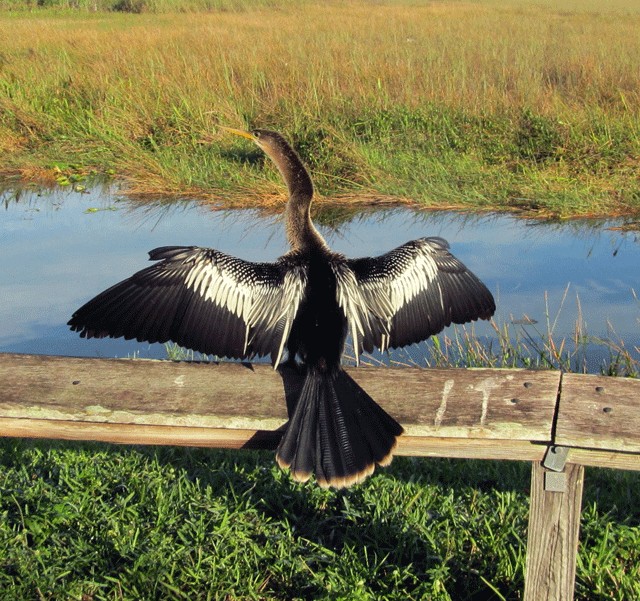Anhinga
A species of Darters and Anhinga, Also known as American Anhinga, Water Turkey Scientific name : Anhinga anhinga Genus : Darters and Anhinga
Anhinga, A species of Darters and Anhinga
Also known as:
American Anhinga, Water Turkey
Botanical name: Anhinga anhinga
Genus: Darters and Anhinga
Description
The anhinga uses its long beak to spear fish. Sometimes the fish gets stuck. and the bird has to swim to shore to pry it off. Unlike most other water birds, the anhinga doesn't have oil glands and therefore its feathers are not waterproof. While the lack of oil does allow the bird to move more efficiently underwater, after swimming it must spread its wings and dry them in the sun.
Size
75 - 95 cm
Life Expectancy
16.4 years
Nest Placement
Shrub
Clutch Size
2 - 5 eggs
Incubation Period
1 brood
Number of Broods
26 - 30 days
Nestling Period
14 - 21 days
Feeding Habits
Anhinga predominantly consumes small to medium-sized wetland fish, with occasional crustaceans and invertebrates. Anhinga hunts by swimming slowly underwater and stalking prey near vegetation, spearing fish with a rapid bill thrust, employing a unique side-spearing technique. Diet varies by region, including mullet, sunfish, catfish, crayfish, insects, and occasionally reptiles.
Habitat
Anhinga primarily inhabits freshwater environments such as shallow lakes and ponds, rivers, streams, and marshes with slow-moving water. They favor warm, sub-tropical to tropical climates, often found at low altitudes. These birds are adapted to areas with dense vegetation like riparian forests but require access to open water for foraging. They utilize surrounding trees and banks for perching to dry their feathers. While typically associated with freshwater, anhinga can inhabit coastal and estuarine areas where they join other waterbird colonies, although they prefer to feed in freshwater habitats.
Nest Behavior
Anhinga nests in loose groups, with males initiating construction by gathering sticks and greenery. Females complete the nests, and both engage in raising the young with a high degree of parental care.
Nest Characteristics
Anhinga typically builds its nest in trees near or over water. The structure is a bulky platform of sticks, lined with fresh leaves and green twigs, and can accumulate a white rim of excrement over time.
Dite type
Piscivorous
People often ask
Migration Overview
Only birds that live in the extreme north and south of their range migrate and do so based on temperature and available sunlight. Anhingas will migrate towards the equator during winter but this range is "determined by the amount of sunshine to warm the chilled birds". Although not in their usual range, anhingas have been found as far north as the states of Pennsylvania and Wisconsin in the United States.
General Info
Feeding Habits
Bird food type
Behavior
Anhinga's distinct swimming style, with their body submerged and only their neck and head visible, is due to their wet plumage and heavy bones, reducing their buoyancy. This adaptation allows them to stealthily hunt for fish underwater. When on the surface, only their bill might be visible, enhancing their aquatic camouflage. Above water, anhingas expertly soar on thermals, reaching high altitudes; their silhouette is characterized by flat, straight wings, an outstretched neck—sometimes with a kink—and their noticeable long tail. This combination of skilled swimming and soaring exemplifies their unique interaction with their habitat, adeptly utilizing both aquatic and aerial environments.
Distribution Area
Anhinga species are found all over the world in warm shallow waters. The American anhinga has been subdivided into two subspecies, A. a. anhinga and A. a. leucogaster, based on their location. A. a. anhinga can be found mainly east of the Andes in South America and also the islands of Trinidad and Tobago. A. a. leucogaster can be found in the southern United States, Mexico, Cuba, and Grenada. 
Scientific Classification
Phylum
Chordates Class
Birds Order
Gannets and Relatives Family
Darters Genus
Darters and Anhinga Species
Anhinga 